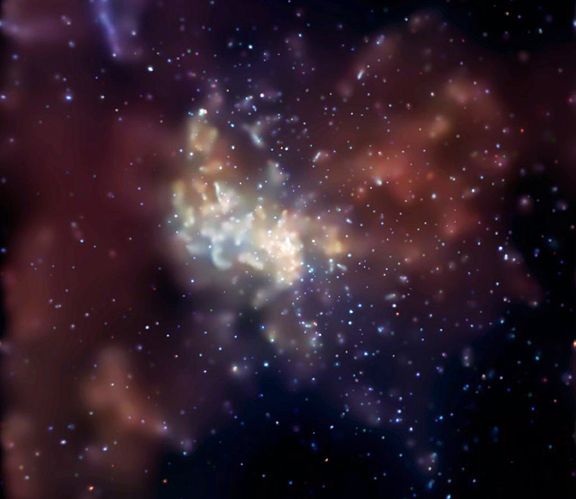Skip to comments.
Astronomy Picture of the Day 1-08-03
NASA ^
| 1-08-03
| Robert Nemiroff and Jerry Bonnell
Posted on 01/08/2003 3:59:33 AM PST by petuniasevan
Astronomy Picture of the Day
Discover the cosmos! Each day a different image or photograph of our fascinating universe is featured, along with a brief explanation written by a professional astronomer.
2003 January 8

X-Rays from the Galactic Core
Credit: Fred Baganoff (MIT), Mark Morris (UCLA), et al., CXC, NASA
Explanation: Using the orbiting Chandra X-ray Observatory, astronomers have taken this long look at the core of our Milky Way galaxy, some 26,000 light-years away. The spectacular false-color view spans about 130 light-years. It reveals an energetic region rich in x-ray sources and high-lighted by the central source, Sagittarius A*, known to be a supermassive black hole with 3 million times the mass of the Sun. Given its tremendous mass, Sagittarius A* is amazingly faint in x-rays in comparison to central black holes observed in distant galaxies, even during its frequent x-ray flares. This suggests that this supermassive black hole has been starved by a lack of infalling material. In fact, the sharp Chandra image shows clouds of multi-million degree gas dozens of light-years across flanking (upper right and lower left) the central region -- evidence that violent events have cleared much material from the vicinity of the black hole.
TOPICS: Astronomy; Astronomy Picture of the Day; Science
KEYWORDS: astronomy; blackhole; center; chandra; clouds; composite; core; galactic; galaxy; gas; hot; hub; image; milkyway; orbiter; photography; sagittariusa; xray
Sagittarius A*:
Milky Way Monster Stars in Cosmic Reality Show
This Chandra image of the supermassive black hole at the Milky Way's center, a.k.a. Sagittarius A* or Sgr A*, was made from the longest X-ray exposure of that region to date. In addition to Sgr A* more than two thousand other X-ray sources were detected in the region, making this one of the richest fields ever observed.
During the two-week observation period, Sgr A* flared up in X-ray intensity half a dozen or more times. The cause of these outbursts is not understood, but the rapidity with which they rise and fall indicates that they are occurring near the event horizon, or point of no return, around the black hole. Even during the flares the intensity of the X-ray emission from the vicinity of the black hole is relatively weak. This suggests that Sgr A*, weighing in at 3 million times the mass of the Sun, is a starved black hole, possibly because explosive events in the past have cleared much of the gas from around it.
Evidence for such explosions was revealed in the image - huge lobes of 20 million-degree Centigrade gas (the red loops in the image at approximately the 2 o'clock and 7 o'clock positions) that extend over dozens of light years on either side of the black hole. They indicate that enormous explosions occurred several times over the last ten thousand years.
Further analysis of the Sgr A* image is expected to give astronomers a much better understanding of how the supermassive black hole in the center of our galaxy grows and how it interacts with its environment. This knowledge will also help to understand the origin and evolution of even larger supermassive black holes found in the centers of other galaxies.
| Fast Facts for Sagittarius A*: |
| Credit |
NASA/CXC/MIT/F.K.Baganoff et al. |
| Scale |
Image is 8.4 arcmin on a side. |
| Category |
Black Hole |
| Coordinates (J2000) |
RA 17h 45m 40s | Dec -29º 00' 28.00" |
| Constellation |
Sagittarius |
| Observation Date |
11 pointings from September 21, 1999 through June 04, 2002 |
| Observation Time |
164 hours |
| Obs. ID |
242, 1561, 2943, 3392, 3393, 3663, 3665, 2951, 2952, 2953, 2954 |
| Color Code |
Energy: Red (2-3.3 keV), Green (3.3-4.7 keV), Blue (4.7-8 keV) |
| Instrument |
ACIS |
| Distance Estimate |
26,000 light years |
|
To: MozartLover; Joan912; NovemberCharlie; snowfox; Dawgsquat; viligantcitizen; theDentist; ...
2
posted on
01/08/2003 4:00:45 AM PST
by
petuniasevan
(Deep undercover in the AFL-CIO)
To: petuniasevan
Mornin' !

To: petuniasevan
very cool. bump!
To: petuniasevan
Good morning
5
posted on
01/08/2003 5:15:34 AM PST
by
firewalk
To: petuniasevan
Beautiful black hole bump! It makes my day to see these photos and the links.
6
posted on
01/08/2003 6:14:15 AM PST
by
xJones
To: petuniasevan
You're an underappreciated blessing. Thanks.
To: petuniasevan
Great work! Thanks for the Info and the cool Picture! APOD the place to be!!!
To: petuniasevan
Good one. The core of the Milky Way was not visible in any way until recently. It's existence was theoretical, but a near certainty. What was there, who knew? Now astronomers are taking a census. It looks like a hot place, possibly not friendly to our kind of life.
To: petuniasevan; yall
Something for all the Eggheads to ponder...
First speed of gravity measurement revealed
NewScientist.com ^ | 01/07/2003 | Ed Fomalont and Sergei Kopeikin
Excerpt:
We became the first two people to know the speed of gravity, one of the fundamental constants of nature," the scientists say, in an article in New Scientist print edition. One important consequence of the result is that it places constraints on theories of "brane worlds", which suggest the Universe has more spatial dimensions than the familiar three.
John Baez, a physicist from the University of California at Riverside, comments: "Einstein wins yet again." He adds that any other result would have come as a shock.
To: petuniasevan
Very nice. Thanks.
To: petuniasevan
Disclaimer:
Opinions posted on Free Republic are those of the individual
posters and do not necessarily represent the opinion of Free Republic or its
management. All materials posted herein are protected by copyright law and the
exemption for fair use of copyrighted works.
FreeRepublic.com is powered by software copyright 2000-2008 John Robinson


